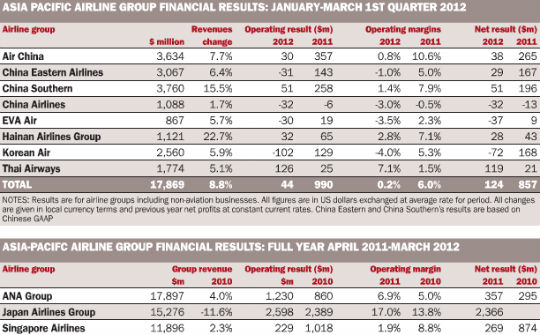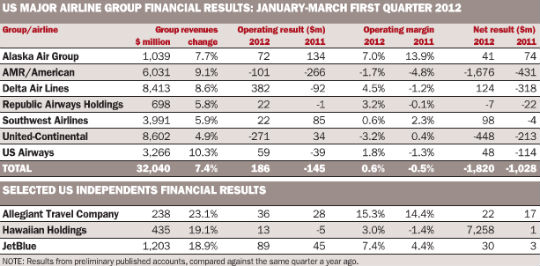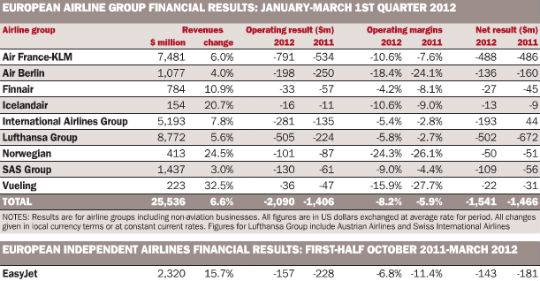Traditionally a tough part of the year for the airline industry, the first quarter of 2012 saw carriers fire plenty of warning shots over the current climate. Economic concerns continue to contribute to the unease. The speed at which the eurozone crisis in Europe has been reignited by political uncertainty in Greece shows how fragile the continent's grip on even slight economic growth might be.
However, while Europe's woes may dominate economic fears, it is the other fundamental headwind facing airlines which hangs heaviest over the industry. While there been a recent relenting on the markets, airline have had to deal with oil prices well above the $100 market for over a year, and hedge benefits are wearing thin for airlines.
Consequently, virtually every airline report in the first three months of the year came with a health warning of some description on the increase of fuel.
The toll of higher oil prices was even evident in stalling the profits at Gulf juggernaut Emirates, where a 44% jump in its fuel bill saw record profits fall 72% to $409 million. All this despite a 15% hike in revenues for the same period.
"This is not just a Cathay Pacific problem; it is clearly an industry-wide issue, and continued high fuel prices in particular are hitting airlines hard across the globe," said Cathay Pacific chief executive John Slosar, in warning of disappointing first-half figures to come and announcing cost-cutting measures.
ASIA FEELS THE PINCH |
|---|
First-quarter results illustrate how fuel and the continued sluggish cargo market have taken their toll in Asia. Operating profits across eight reporting carriers show the combined profits of $1 billion for the same period last year were all but wiped out in the first three months of this year (see below). The same eight carriers could generate net profits of only $124 million during the same period. Of these eight carriers, only Thai Airways could point to an improvement year-on-year for the first quarter.
 |
|---|
Singapore Airlines, for example, saw rising fuel prices and depressed yields - especially on long-haul and premium services - in reporting a rare quarterly loss for the three months to March. Group revenues for its fiscal fourth quarter grew 3%, but were outstripped by an 8% rise in expenditure as the cost of fuel before hedging rose 15%. As a result, it posted an operating loss of $4 million versus a healthy profit a year before.
This compounded a difficult year in which its full-year operating profits fell from more than $1 billion to $229 million.
SIA's full-year traffic growth of 3.6% failed to keep pace with the 5% additional capacity, resulting in load factor falling a point to 77.4%. Its passenger break-even load factor rose three points to 78% on lower yields and higher unit costs. Yields fell 3.3% year on year during the fourth quarter across all cabin classes, and are expected to stay flat in the near term, say airline executives.
Against this backdrop, SIA aims to grow the role of its SilkAir regional subsidiary. It is set to increase capacity at the regional carrier by nearly a quarter in its current fiscal year via additional aircraft and higher utilisation, while the mainline carrier's capacity will be lifted only 3%.
This will enable the subsidiary, which operates Airbus A320s, to become a more effective regional full-service competitor to low-cost carriers, and provide additional feed for SIA's medium and long-haul operations.
"We are eyeing all key markets for SilkAir. We will push ahead with expansion into China, India and Indonesia. Because of our joint planning with SIA, we are also looking at developing points together in some routes that may need an extra window. SilkAir's recent expansion into Hanoi is an example of that," says SIA chief executive Goh Choon Phong.
Longer term, SIA is realigning its growth strategy by diversifying its profit streams. One example is Scoot, the long-haul, low-cost subsidiary that launches in June to compete not only with the likes of AirAsia X and Jetstar Asia, but also with other premium carriers such as Thai Airways.
Another example is via joint ventures such as that with Virgin Australia, which gives it access to domestic points in an important market. Goh says SIA is open to potential partners worldwide - a subsequent joint-venture agreement with SAS attests to that.
But the focus remains on developing markets, with some sources saying joint ventures with - and maybe even an investment in - airlines from India and China could be on the cards. A partnership will work, adds Goh, only if there is "synergy" between the airlines that are in it.
SIA remains "open to investment if there are good opportunities", adds Goh, who declines to say if it will revive its old interest in China Eastern Airlines. "We remain interested in China and in any other growth area for potential investment possibility."
STORM CLOUDS OVER EUROPE |
|---|
While profits in Asia have been curtailed in the first quarter, in Europe it was a battle to minimise losses during the period. High fuel prices and flat-lining economies made for a difficult backdrop in the tough quarter.
Figures for the first quarter show nine selected European carrier groups racked up collective operating losses of more than $2 billion - almost 50% higher than the same period last year (see below). None of these carrier groups recorded either an operating or net profit.
|
|
|---|
More than half these losses were incurred by network carrier giants Lufthansa and Air France-KLM, including operating losses of $500 million and $800 million respectively. Lufthansa has embarked on a major cost-reduction programme which aims to improve financial performance by at least €1.5 billion ($1.9 billion) through cutbacks and higher sales.
Air France-KLM is also eyeing major restructuring. It faces the thorny issue of implementing its wide-ranging Transform 2015 plan. Under its 2012-2014 plan to return to profitability it aims to cut €2 billion from its net debt. Half of this will be delivered via cost-saving efforts and the remainder through a transformation plan across all its business.
The need for action was further underlined when the group saw its operating losses deepen in the first quarter to $791 million - the heaviest loss for the period registered by European carriers. Again, fuel was a prime factor. Revenue gains of 6% were far outweighed by an 18% increase its fuel costs - only one percentage point of which was attributable to increased fuel use.
For International Airlines Group its first-quarter challenges were exacerbated by a pilots strike surrounding the launch of Iberia Express as its solution to short-haul flights out of Madrid.
"But we see a positive pattern [for the rest of the year] that will more than offset losses in the first quarter," says chief financial officer Enrique Dupuy. It expects to break even for the full year once an estimated €240 million hit from its BMI acquisition - resulting from ongoing losses and restructuring costs - is absorbed.
IAG chief executive Willie Walsh expects this to be a year of change in the industry. "I think the high oil price and the impact that is having on profitability will drive weaker airlines out of business," he says. He believes this will have a positive impact for the wider health of the industry and sees encouragement from airline behaviour today.
"I think the fact the industry has demonstrated so much discipline in relation to capacity tells you that it is different today than we have seen before, and that points to me to a much more rationale future," he says.
EasyJet cites flat competitor capacity, partly through airline collapses, as a key factor in managing to cut first half losses. This is alongside its own "more rigorous approach" to capacity. The airline aims to thin or drop between 5-10% of its capacity each year to and redeploy more profitability elsewhere - moving aircraft from 15 loss-making routes in the last six months. "We are investing in the markets [where] we know we can drive returns," says chief executive Carolyn McCall.
Ryanair became the latest European carrier to report its financial today, revealing net profits for the full-year up a quarter at €503 million. It also offered some incidation on the year ahead, guiding for slightly reduced net profits in the region of €400-440 milion for the year to March 2013. While the carrier has in the past taken a cautious line on its forecasts - its original expectations for the year just finished was for profits to stay flat - its chief executive Michael O'Leary believes economic woes and austerity measures are likely to limit its ability to recover higher fuel costs through yield gains.
"I think we are right to be more conservative. I think it will be a very difficult fares environment this winter," he says. Average fares grew 15 per cent in the last year - off a base of 40 euros - continuing a run of three years of double-digit yield growth. "But I don't believe there will be a fourth year of double digit fare increases," says O'Leary.
While he says the carrier has no visibility into the winter, he says one of the knowns is that its fuel bill will be 320 million euros higher. "On balance I think it will be difficult," he says. "We need airfares to rise 15 per cent to pay for the oil bill and I think its unlikely."
FUEL HITS US CARRIER GAINS |
|---|
US carriers' earnings were dragged down by rising fuel prices in the seasonally challenging first quarter, with consolidation events and maintenance costs putting a further dent in the profitability of certain airlines. Spikes in jet fuel prices drove growing expense bills across US mainline and low-cost carriers, contributing to net losses reported by United-Continental, Delta Air Lines and US Airways. This excludes the extraordinary losses posted by American Airlines as it works through Chapter 11 bankruptcy protection.
 |
|---|
Almost all of United-Continental's year-on-year $618 million increase in operating expense was represented by fuel costs. The Star Alliance carrier made a net loss of $286 million in what chief executive Jeff Smisek calls a "challenging quarter".
Delta made a net loss of $39 million excluding special items, although it notes that it was the best first quarter the airline has generated since 2000. Operating expenses for the quarter rose 4%, again largely driven by fuel expenses which rose $250 million.
US Airways, which posted a net loss of $22 million excluding special items for the quarter, says its results were "significantly" impacted by higher fuel prices. Its chief financial officer Derek Kerr points out that if oil prices had stayed flat, the Star Alliance carrier's fuel expense would have been $133 million lower.
Rising fuel bills were also a reality at other US carriers such as Hawaiian Airlines and Alaska Air as well as among US low-cost carriers, although some managed to offset this increase with higher operating revenues.
Alaska Air remained profitable with a 45% fall in net profit to $40.8 million, even as its fuel expenses surged by 64%.
Low-cost carrier JetBlue was able to "fully offset" increased fuel prices with record revenues of $1.2 billion. The carrier almost doubled its operating profit for the first quarter to $89 million.
"A strong pricing environment and the ability to execute on our network strategy in key markets, such as Boston and the Caribbean, allowed us to achieve these strong results," says the carrier's chief executive Dave Barger.
Fuel bills will remain a substantial concern in the second quarter, and US mainline carriers continue to emphasise capacity discipline for the months ahead.
United-Continental's chief revenue officer Jim Compton says: "The current economic environment is still uncertain, with pockets of strength and weakness, and oil remains high and volatile. We expect our 2012 capacity to decrease between 0.5% and 1.5% versus 2011, which will make our airline 1% smaller than we were in 2010 and 7% smaller than we were in 2008."
Delta, meanwhile, expects a "solidly profitable" second quarter as it reduces system-wide capacity by 1% to 3%. Besides rising fuel bills, consolidation events and their related costs also impacted results at United-Continental and Southwest Airlines.
United-Continental transitioned to a single passenger service system in the quarter - one of the most complex steps in an airline merger - and acknowledged the move had put pressure on unit revenues. Carrier executives emphasise the initial teething pains are over. "Now that we have over one and a half months of using the system, we have returned to our historic booking levels, which will support better revenue performance in April and beyond," says Compton.
Southwest, which acquired AirTran a year ago, is in the process of integrating the two airline networks. It estimates integration costs will reach about $500 million. Southwest is also in the midst of adding more seats to its 372 Boeing 737-700s, which will increase maintenance bills.
However, the airline's chief executive Gary Kelly believes the AirTran integration and cabin retrofit, while putting pressure on costs in the short term, will deliver revenue improvements once complete. "Looking back over the last five years, we've delivered against what we said we were going to do. So I feel very confident that the company will deliver," he says.
The carrier, though, is deferring dozens of aircraft deliveries scheduled for 2013 and 2014 to 2017 and 2018, in a move Kelly says will save the airline more than $1 billion in capital spending.
Traffic figures for the first quarter - with capacity essentially flat - show US carriers' tight grip on supply remains.
"Over the last three years you've always had these waves where capacity is withdrawn and historically, people like Southwest have grown through these cycles," says aviation consultant Robert Mann.
However, he notes the carrier, along with other airlines, remains disciplined on capacity, while the lack of new entrants into the market is helping to keep capacity tight.
REPORTING: Graham Dunn/London, Siva Govindasamy/Singapore, Ghim-Lay Yeo/Washington DC
Source: Air Transport Intelligence news
























